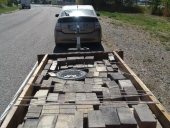Steven Smith wrote:WE HAVE A BIG AREA AND WANT TO RUN 8" PIPE ABOUT 35 FEET.
That sounds like a good length. Any shorter than that and the system would not reap enough of the heat from the exhaust before it exits the building. In other words, it would be less efficient and the exhaust's exit-temperature would be hotter than usual.
Steven Smith wrote:HOW HEAVY A PIPE DO I NEED TO USE USE IN THAT LENGTH OF SOLAR BATTERY?
By heaviness do you mean thickness? What does length-of-pipe have to do with heaviness-of-pipe, anyway? Don't most rocket mass heaters use the same gauge pipe, anyway? I suppose that with a larger diameter system (for example, 8" rather than 6") you may get some pretty hot temperatures. Such temperatures have been known to 'eat' the steel pipe (that is, the high heat causes the metal to deteriorate and flake-off over time); however, if the rocket mass heater is built appropriately, the clay content in the insulation of the heat-riser --as well as the clay in the thermal battery-- should maintain the smooth shape of the system, regardless of whether the steel frays away or not; so, more or less, the ducting acts as a mold for the first portion of the rocket-mass-heater's life-- after which, the clay holds the shape. Anyway, also, high temperatures can cause the zinc on galvanized duct to vaporize (resulting in heavy-metal-poisoning or something like that); make sure to use black stove pipe or stainless steel stove pipe (not galvanized duct) during the first portions of the rocket mass heater (in the heat-riser or in the first 8 feet of the bench)... farther down the system, where temperatures are cooler, galvanized pipe should be okay.
Steven Smith wrote:I DON'T WANT TO GET ANOTHER JOB TO PAY FOR IT.
Please remember that
1) this stove may be dangerous if built improperly (heavy-metal-poisoning; carbon monoxide poisoning; the heater's 5-ton-weight causing the floor of your living-room to collapse; etc)
2) it may last for a very very long time
3) it will save you a lot of money on heating.
So all I'm saying is, a little bit of time, money, patience... can pay off in the long run.
Having just built one myself, I found out how complex some aspects of the project can be-- especially since I was doing it mostly by myself.
Now, I'm not trying to sell anything to you, because I have nothing to gain from doing that. But anyway, I seriously recommend making a small investment in Ianto and Leslie's book, which can be found here:
http://rocketstoves.com/
or here
http://www.amazon.com/Rocket-Mass-Heaters-Superefficient-Woodstoves/dp/0966373839
The book is great; it is simple, straight-forward, and it covers a lot of crucial details that may otherwise be less obvious.
Or, if you want, order a copy of the Erica and Ernie Wisner's blueprints, which can be found here:
http://www.ernieanderica.info/shop
Also, for free, you can check out these websites:
http://www.ernieanderica.info/rocketstoves
http://www.richsoil.com/rocket-stove-mass-heater.jsp
Also, those websites include more links to more helpful websites.
Steven Smith wrote:WHAT TYPE OF TEMPERATURES ARE GOING THRU IT?
That depends on how much wood you shove in there. During a podcast with Erica Wisner and Paul Wheaton, Ernie Wisner mentioned how some people say that it is impossible for wood-heat to get above a certain temperature; furthermore, he doesn't know how it works, but the temperature gets way hotter than those people think. (Hear the podcast, here
http://www.richsoil.com/permaculture/182-rocket-mass-heaters-permaculture-podcast-019/ ) I seem to remember hearing that rocket-mass-heaters can produce internal-temperatures of somewhere around 1500-2000 degrees farenheit. Also, somebody built a system to automatically feed wood-chips into their rocket-mass-heater, but the thing got out of control and they had a red-hot barrel melt-down on their hands!
Good luck!



